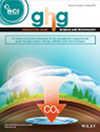Abhishek Gupta, Akshoy Ranjan Paul, Anuj Jain, Ramesh K. Agarwal
求助PDF
{"title":"低渗层数对露天含水层地质固碳影响的研究","authors":"Abhishek Gupta, Akshoy Ranjan Paul, Anuj Jain, Ramesh K. Agarwal","doi":"10.1002/ghg.2334","DOIUrl":null,"url":null,"abstract":"<div>\n \n <p>The use of fossil fuels to fulfill energy demand is responsible for CO<sub>2</sub> emissions, resulting in global warming and climate change. Despite the expansion in renewable energy sources, energy combustion and industrial processes caused a 0.9% increase (321 Mt) in global CO<sub>2</sub> emissions to a record high of 36.8 Gt in 2022. Carbon capture and sequestration (CCS) technology can allow the use of fossil fuel without damaging the environment by storing CO<sub>2</sub> underground, paving the way for a sustainable, low-carbon future. Without fracturing, both homogeneous and low-permeability aquifers can safely accommodate injected CO<sub>2</sub>. This study investigates the effect of low-permeability layers composed of sandstone and shale layers on the capacity and performance of CO<sub>2</sub> storage in open saline aquifers. The CO<sub>2</sub> migration, dispersion, and reservoir pressure variations have been numerically investigated in a computational domain representing the Utsira Formation in Sleipner CCS project. In a homogeneous aquifer, rapid vertical migration results in 65% of the injected CO<sub>2</sub> accumulating at the top layer after 30 years. However, the presence of four low-permeability layers reduces this accumulation to 58% over the same period, demonstrating enhanced trapping efficiency. Long-term simulations indicate that CO<sub>2</sub> accumulation at the top surface increases to 75% of the total injected volume over 80 years. CO<sub>2</sub> dissipates and migrates over time, resulting in a decrease in surface pressure. Pressure analyses reveal that the peak injection-induced pressure remains within the fracture pressure limit (20–25 MPa), ensuring safe storage. After 30 years of injection, pressure at the top surface drops by 0.27 MPa (2.72%) within 2 years post-injection and continues to decrease gradually. This investigation contributes to a better understanding of the dynamics of CO<sub>2</sub> storage in open saline aquifers, thereby facilitating the development of effective CO<sub>2</sub> sequestration strategies. © 2025 Society of Chemical Industry and John Wiley & Sons, Ltd.</p>\n </div>","PeriodicalId":12796,"journal":{"name":"Greenhouse Gases: Science and Technology","volume":"15 2","pages":"206-218"},"PeriodicalIF":2.8000,"publicationDate":"2025-03-10","publicationTypes":"Journal Article","fieldsOfStudy":null,"isOpenAccess":false,"openAccessPdf":"","citationCount":"0","resultStr":"{\"title\":\"A Study on Effect of Number of Low-Permeability Layers on Geological Carbon Sequestration in an Open Aquifer\",\"authors\":\"Abhishek Gupta, Akshoy Ranjan Paul, Anuj Jain, Ramesh K. Agarwal\",\"doi\":\"10.1002/ghg.2334\",\"DOIUrl\":null,\"url\":null,\"abstract\":\"<div>\\n \\n <p>The use of fossil fuels to fulfill energy demand is responsible for CO<sub>2</sub> emissions, resulting in global warming and climate change. Despite the expansion in renewable energy sources, energy combustion and industrial processes caused a 0.9% increase (321 Mt) in global CO<sub>2</sub> emissions to a record high of 36.8 Gt in 2022. Carbon capture and sequestration (CCS) technology can allow the use of fossil fuel without damaging the environment by storing CO<sub>2</sub> underground, paving the way for a sustainable, low-carbon future. Without fracturing, both homogeneous and low-permeability aquifers can safely accommodate injected CO<sub>2</sub>. This study investigates the effect of low-permeability layers composed of sandstone and shale layers on the capacity and performance of CO<sub>2</sub> storage in open saline aquifers. The CO<sub>2</sub> migration, dispersion, and reservoir pressure variations have been numerically investigated in a computational domain representing the Utsira Formation in Sleipner CCS project. In a homogeneous aquifer, rapid vertical migration results in 65% of the injected CO<sub>2</sub> accumulating at the top layer after 30 years. However, the presence of four low-permeability layers reduces this accumulation to 58% over the same period, demonstrating enhanced trapping efficiency. Long-term simulations indicate that CO<sub>2</sub> accumulation at the top surface increases to 75% of the total injected volume over 80 years. CO<sub>2</sub> dissipates and migrates over time, resulting in a decrease in surface pressure. Pressure analyses reveal that the peak injection-induced pressure remains within the fracture pressure limit (20–25 MPa), ensuring safe storage. After 30 years of injection, pressure at the top surface drops by 0.27 MPa (2.72%) within 2 years post-injection and continues to decrease gradually. This investigation contributes to a better understanding of the dynamics of CO<sub>2</sub> storage in open saline aquifers, thereby facilitating the development of effective CO<sub>2</sub> sequestration strategies. © 2025 Society of Chemical Industry and John Wiley & Sons, Ltd.</p>\\n </div>\",\"PeriodicalId\":12796,\"journal\":{\"name\":\"Greenhouse Gases: Science and Technology\",\"volume\":\"15 2\",\"pages\":\"206-218\"},\"PeriodicalIF\":2.8000,\"publicationDate\":\"2025-03-10\",\"publicationTypes\":\"Journal Article\",\"fieldsOfStudy\":null,\"isOpenAccess\":false,\"openAccessPdf\":\"\",\"citationCount\":\"0\",\"resultStr\":null,\"platform\":\"Semanticscholar\",\"paperid\":null,\"PeriodicalName\":\"Greenhouse Gases: Science and Technology\",\"FirstCategoryId\":\"93\",\"ListUrlMain\":\"https://scijournals.onlinelibrary.wiley.com/doi/10.1002/ghg.2334\",\"RegionNum\":4,\"RegionCategory\":\"环境科学与生态学\",\"ArticlePicture\":[],\"TitleCN\":null,\"AbstractTextCN\":null,\"PMCID\":null,\"EPubDate\":\"\",\"PubModel\":\"\",\"JCR\":\"Q3\",\"JCRName\":\"ENERGY & FUELS\",\"Score\":null,\"Total\":0}","platform":"Semanticscholar","paperid":null,"PeriodicalName":"Greenhouse Gases: Science and Technology","FirstCategoryId":"93","ListUrlMain":"https://scijournals.onlinelibrary.wiley.com/doi/10.1002/ghg.2334","RegionNum":4,"RegionCategory":"环境科学与生态学","ArticlePicture":[],"TitleCN":null,"AbstractTextCN":null,"PMCID":null,"EPubDate":"","PubModel":"","JCR":"Q3","JCRName":"ENERGY & FUELS","Score":null,"Total":0}
引用次数: 0
引用
批量引用




 求助内容:
求助内容: 应助结果提醒方式:
应助结果提醒方式:


